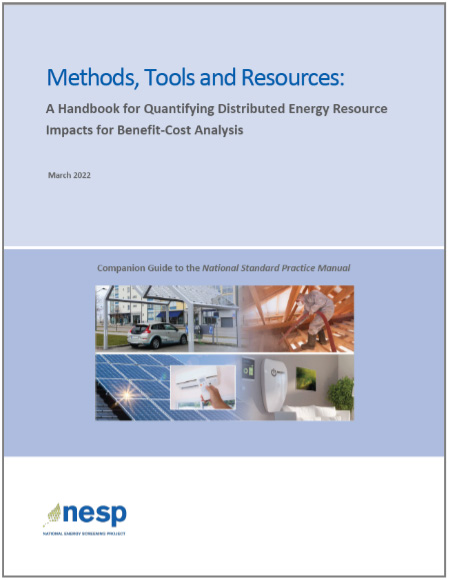Methods, Tools and Resources Handbook
March 2022

The 250+ page Methods, Tools and Resources Handbook for Quantifying DER Impacts for Benefit-cost Analysis (“MTR handbook”) serves as a companion document to the 2020 National Standard Practice Manual (NSPM).
While the NSPM provides guidance on identifying what benefits and costs should be accounted for in a jurisdiction’s primary cost-effectiveness test, the MTR handbook provides technical information on how benefits and costs of DER investments can be quantified (monetized or otherwise), with links to resources and tools.
What you will find in the MTR handbook:
- An overview of the key steps that can be used to calculate BCA inputs, including important concepts (e.g., how to develop Reference and DER Cases, and determine incremental impacts of changes to the utility system).
- Descriptions for how to calculate inputs for the full range of DER impacts for: electric utility system impacts, gas utility system impacts, other fuel system impacts, host customer impacts, and societal impacts.
- A chapter on accounting for energy equity and the relevance of BCA and complementary distributional analysis.
- Guidance on methods for accounting for reliability and resilience, as well as risk and uncertainty, in a BCA.
- Descriptions of how to calculate operating profiles for DERs (e.g., to inform temporal impacts).
- Links to key resources, including modeling tools, with examples of where certain methods have been applied.
- A bibliography of publicly available documents, data sources and modeling tools that can be used to develop BCA inputs
The MTR handbook is intended to be a reference guide for anyone preparing a BCA for DERs, including utilities, regulators and regulatory staff, state energy offices, evaluators, practitioners, consultants, and other stakeholders in the DER regulatory process. It can also provide guidance for parties that review, critique, and comment on BCAs.
The MTR handbook is a living document that will be updated to the extent possible as new tools, techniques and resources become available.

